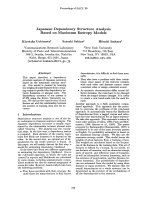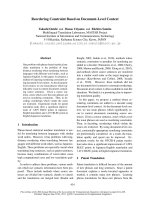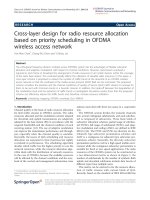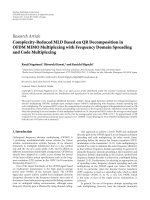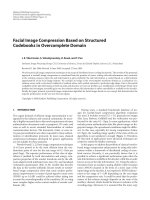Genetic diversity analysis based on molecular level in selected Brassica compestris L. var. toria genotypes
Bạn đang xem bản rút gọn của tài liệu. Xem và tải ngay bản đầy đủ của tài liệu tại đây (1.25 MB, 8 trang )
Int.J.Curr.Microbiol.App.Sci (2018) 7(7): 3604-3611
International Journal of Current Microbiology and Applied Sciences
ISSN: 2319-7706 Volume 7 Number 07 (2018)
Journal homepage:
Original Research Article
/>
Genetic Diversity Analysis Based on Molecular Level in Selected
Brassica compestris L. var. toria Genotypes
J.L. Salam1*, N. Mehta2, A.K. Sarawagi2, Ritu R. Saxena2, S. Verulkar and N. Tomar3
1
S.G. College of Agriculture and Research Station, Jagdalpur 494005 Chhattisgarh, India
2
College of Agriculture, Raipur IGKV, Raipur 494012 Chhattisgarh, India
3
College of Horticulture, Rajnandgaon Chhattisgarh, India
*Corresponding author
ABSTRACT
Keywords
Brassica
Brassica
compestris,
compestris,
Toria,
Toria,
Genetic
Genetic diversity
diversity
Article Info
Accepted:
Accepted:
26
26 June
June 2018
2018
Available
Available Online:
Online:
10
10 July
July 2018
2018
The present study was carried out at Dr R.H. Richharia Research Laboratory, Department of
plant molecular biology and biotechnology, College of Agriculture Raipur (C.G.), Indira
Gandhi Krishi Vishwavidyalaya, Raipur (Chhattisgarh) during Rabi 2013-14. Experimental
materials comprised 24 Brassica compestris L. var. toria genotypes with the objectives to
estimate the genetic diversity analysis at molecular level. The present investigation genetic
diversity at molecular level in 24 genotypes of toria, two major cluster with 53% genetic
similarity in which two genotypes named GPT-13 and GPT-59 comes under one cluster and
remaining 22 falls under second cluster. Genotypes GPT-1 and GPT-43 and genotype GPT125 and GPT-126 exhibited 87% genetic similarity with each other. These results indicated
the existence of sufficient Variability among genotypes and there are very much chance of
improvement either through selection or through hybridization by getting heterosis.
of mixing the sweet ‘must’ of old wine with
crushed seeds of black mustard (Brassica
nigra (L.) Koch) to form a hot paste,
respectively.
Introduction
Rapeseed-Mustard group of crops is among
the oldest cultivated plants in human
civilization. Biologically, the rapeseed and
mustard plants belongs to the family
Crucifarae and under the genus Brassica with
large number of species and sub species
cultivated in India. The word ‘rape’ and
‘mustard’ have been derived from the word
rapum meaning turnip and European practice
Rapeseed mustard crops in India comprise
traditionally grown indigenous species namely
toria (Brassica campestris L.var. toria), brown
sarson (Brassica campestris L. var. brown
sarson), yellow sarson (Brassica campestris
L. var yellow sarson), Indian mustard
(Brassica juncea L. Czern and Coss), black
20
Int.J.Curr.Microbiol.App.Sci (2018) 7(7): 3604-3611
mustard (Brassica nigra) and taramira (Eruca
sativa Mill), which have been grown since
about 3500 BC along with non-traditional
species like gobhi sarson (Brassica napus L.)
and Ethopian mustard or Karan rai (Brassica
carinata A. Braun) (Chouhan et al., 2011).
The rapeseed-mustard group is comprised of
two distinct type (i) self pollinated – Indian
mustard, raya and yellow sarson of which
Indian mustard is the most important member
of the group accounting for 75-80 per cent of
the area under rapeseed-mustard and (ii) cross
pollinated – brown sarson, toria and taramira.
assayed by amplified fragment length
polymorphism (AFLP) markers, all the Indian
and Chinese B. juncealines were clustered
together whereas lines from other sources
formed another group (Srivastava et al.,
2001). RAPD analysis indicated that the
genetic relationship of Chinese oilseed
mustard accessions was mainly decided by the
specific ecological environment as well as the
local cultivation customs and high diversity of
B. juncea was discovered in south-western and
western China (Puet et al., 2007). This is
supported by the analysis using AFLP,
sequence-related amplified polymorphism
(SRAP) and simple sequence repeat (SSR)
markers (Xu et al., 2008). Analysis using
SRAP markers revealed that the Chinese
oilseed mustards were divided into different
groups mainly according to their growth
habitat (Wu et al., 2009). SSR allelic diversity
in the A genome and B genome supported a
polyphyletic origin and secondary centres of
genetic diversity of oilseed B. juncea in China
and India (Sheng et al.)
Among rapeseed-mustard group toria is an
important oilseed considered as a catch crop in
early rabi season of India. Toria has a
relatively dwarf plant frame, short duration
(70-80 days), small seeded siliquae and
mature early and susceptible to aphids,
alternaria blight and frost. Toria seeds are
spherical or ovoid in shape and are reddish or
dark brown in colour, having slightly wrinkled
surface. Seeds are slightly smaller than those
of mustard. It is cultivated largely in Assam,
Bihar, Orissa and West Bengal mainly as
winter crop. In Chhattisgarh the productivity
of toria is very low comparable to the national
productivity and other states like Haryana
(1609 kg), Gujrat (1577 kg), Rajshthan (1187
kg), Uttar Pradesh (1125 kg) and Madhya
Pradesh (1108 kg) etc. The reasons for low
productivity of toria due to local genotypes
which have low yielder, dwarf in nature,
bushy or trailing habit and susceptible to
alternaria blight, powdery mildew and aphids
etc. This results in a big gap between
requirement and production of rapeseed and
mustard in Chhattisgarh and India.
In Chhattisgarh, large number of local toria
germplasm is available. Hence, local
genotypes of toria can be upgraded by
crossing with improved varieties. This will
lead to the higher yield and oil content in local
genotypes of toria along with good adaptation.
Materials and Methods
The present study entitled “Genetic diversity
analysis based on molecular level in selected
Brassica compestris L. var. toria genotypes”
was carried out at Dr R.H. Richharia Research
Laboratory, Department of plant molecular
biology and biotechnology, College of
Agriculture Raipur (C.G.), Indira Gandhi
Krishi
Vishwavidyalaya,
Raipur
(Chhattisgarh)
during
Rabi
2013-14.
Experimental
materials
comprised
24
Brassica compestris L. var. toria genotypes
with the objectives to estimate the genetic
diversity analysis at molecular level.
Molecular markers provided an important tool
for the genetic diversity study of Indian and
Chinese oilseed mustard. All Indian
accessions grouped together as assayed by
random amplified polymorphic DNA (RAPD)
(Jain et al., 1994; Khan et al., 2008). As
21
Int.J.Curr.Microbiol.App.Sci (2018) 7(7): 3604-3611
Doc software Version 2.0.1(Bio-Rad, USA)
Data analysis
Genomic DNA isolation
DNA was isolated by modified CTAB method
of DNA extraction for Rapeseed as suggested
by Jonathan and Wendel (1990).
The band profiles were scored only for
distinct, reproducible bands as present (1) or
absent (0) for each ISSR primer pair. Jaccard’s
similarity coefficient values were calculated
and dendrogram based on similarity
coefficient values were generated using
unweighted pair-group method with arithmetic
mean (UPGMA) by the NTSYSpc 2.10e
software (Rohlf, 2000). The polymorphism
information content (PIC) value of ISSR
markers was calculated using the following
formula (Anderson et al., 1993).
The leaf bits were cut in an eppendrof tube.
Added 700 µl CTAB buffer in this and kept it
at 40 C for 3-4 hrs. Grinded the leaf and added
some more CTAB buffer. Kept it in water bath
at 650C for 20 min. Added 700 µl of
chloroform: isoamyl alcohol (24:1). Then
vortex the sample. Centrifuged it for 20min. at
14000 rpm. Transferred the upper clear layer
in new 1.5 ml Eppendrof tube (Repeat twice
from the step 5-8). Added 175 µl of 3M
sodium acetate and 400 µl of ice cold
isopropanol in this and kept it for incubation at
-200C for overnight. Centrifuged at 14000 rpm
for 20 min. and discarded the supernatant.
Then washed the pellet with 70% ethanol (50
µl). Centrifuged it for 10 min. Air dried the
pellet. Added 100µl of TE buffer and
dissolved the pellet.
PIC=
Where k is the total number of alleles (bands)
detected for one ISSR locus and P1 is the
frequency of the ith allele (band) in all the
samples analyzed.
Results and Discussion
Genetic diversity on the molecular markers
in selected toria genotypes
DNA quantification
Four ISSR primers were used to study the
genetic diversity among twenty four
genotypes (Fig. 1 and 2). All were showed
polymorphic. The similarity coefficient ranged
from 0.53 to 0.87. Turi et al., (2012) at
Peshawar, Pakistan investigated genetic
diversity among 120 different accessions of
Brassica species were characterized with the
help of SSR markers. 39 SSR primers were
used and they produced 162 scorable bands in
which 105 were polymorphic. The average
rate of polymorphic loci was 46%, which
indicates high genetic diversity among the
accessions. The UPGMA cluster analysis
revealed two main clusters and nine subclusters. The dandogram indicated that based
on above maker study formed two major
clusters namely ‘A’ and ‘B’. Two genotypes
named GPT-13 and GPT-59 comes under one
The concentration and quality of the genomic
DNA sample were estimated on spectrometer
ND-2000 (Nanodrop, USA). Finally, all the
genomic DNA samples were diluted to a final
concentration of 40 ng/µl with autoclaved
distilled water and stored at -200C for further
use.
PCR amplication of ISSR markers
A total of 4 ISSR primers of toria were used in
this study. Polymerase chain reaction (PCR)
for amplification of DNA preparation was
carried out in a 25 µl for ISSR. All PCR
reaction were carried out in a Veriti Thermal
Cycler-96 mells (Applied Biosystem, USA).
PCR products were separate using 5% PAGE,
stained with ethidium bromide and
photographed under UV light using Image Gel
22
Int.J.Curr.Microbiol.App.Sci (2018) 7(7): 3604-3611
cluster ‘A’ with 53% genetic similarity while,
remaining 22 genotypes falls under second
cluster B with 66% genetic similarity. Shiran
et al., (2004) at studied Shahre Kord, Iran the
genetic diversity among twenty seven
rapeseed (Brassica napus) cultivars and one
cultivar of Brassica rapa was investigated
using Random Amplified Polymorphic DNA
(RAPD) molecular marker. A set of twenty
four ten-mer arbitrary primers was used which
produced reliable polymorphic DNA bands
ranging in molecular weight from 440 to 3299
bp. A total of 133 polymorphic bands out of
173 reproducible bands were obtained.
Genetic similarity matrix based on Jaccard’s
index detected coefficient ranging from 0.38
to 0.78. Coefficients were used to contrast a
dendrogram using unweighted paired group of
arithmetic mean (UPMGA) algorithm.
Cultivars were clustered into two major
groups.
In major cluster ‘B’ showed two sub-clusters
as ‘B1’ and ‘B2’ near the 70% similarity level.
Genotypes GPT-1 with GPT-43 and genotype
GPT-125 with GPT-126 exhibited 87%
genetic similarity with each other. Genotype
PT 507, PT 30 and GPT-48, GPT-54 exhibited
79% genetic similarity. Hasan et al., (2006) at
Giessen, Germany studied set of ninety six
genotypes was characterised using publicly
available mapped SSR markers spread over
the Brassica napus genome. Allelic
information from 30 SSR primer combinations
amplifying 220 alleles at 51 polymorphic loci
provided unique genetic fingerprints for all
genotypes. UPGMA clustering enabled
identification of four general groups with
increasing genetic diversity as follows (1)
spring oilseed and fodder; (2) winter oilseed;
(3) winter fodder; (4) vegetable genotypes
(Table 1).
Table.1 Detail about ISSR markers used for diversity analysis in toria
Marker
UBC 807
UBC 810
UBC 812
UBC 815
Sequence
AGAGAGAGAGAGAGAGT
AGAGAGAGAGAGAGAGT
AGAGAGAGAGAGAGAGA
CTCTCTCTCTCTCTCTG
# of bp
17
17
17
17
23
Tm
42.5
42.9
44.3
44.9
Yield
14.6
21.8
18
83.3
Fig.1 Dendrogram constructed using UPGMA based on Jaccard’s coefficient of 24 Brassica compestris var. Toria genotypes (ISSR
Markers)
Fig.2 ISSR Profile generated by UBC 810, UBC 807, UBC 812 and UBC 815 primers of 24
Toria germplasm including varieties
UBC 810
UBC 807
UBC 812
UBC 815
These results indicated the existence of
sufficient Variability among genotypes and
there are very much chance of improvement
either through selection or through
hybridization by getting heterosis. This result
also indicated that ISSR analysis is effective
for the assessment of genetic diversity among
Brassica compestris genotypes. A similarity
matrix based on the proportion of shared
ISSR fragments was used to establish the
level of relatedness between the various
collected toria genotypes. These results were
further strengthened by the earlier findings of
Yu et al., (2007), Abbas et al.(2009), Ghosh
et al., (2009), Moghaddam et al., (2009),
Villa et al., (2009), Ali et al., (2011), Das et
al., (2011), Molla et al., (2011), Abtahi and
Arzani (2013), Vinu et al., (2013), Tahira et
al., (2014), Ahmad et al., (2014) and Iqbal et
al., (2015).
Acknowledgement
I am immensely thankful to Dr. S.C.
Mukherjee, Dean, S.G. College of Agriculture
& Research station, Jagdalpur (Chhattisgarh),
India other technical and non-technical staff
members of Department of Genetics and Plant
Breeding, for their valuable suggestions, kind
cooperation and encouragement during the
investigation.
References
Abbas, H.G., Mahmood, A. and Ali, Q. 2015. An
overview of genetic variability and gene
action to improve yield of brassica napus.
Nature and Science, 13(4): 28-35.
Abbas, S.J., Farhatullah, Marwat, K.B., Khan,
I.A. and Munir, I. 2009. Molecular analysis
of genetic diversity in Brassica species. J.
Bot., 41(1): 167-176.
Abtahi, M. and Arzani, A. 2013. Molecular and
morphological assessment of genetic
variability induced by gamma radiation in
canola. J. Pl. Mole. Breed., 1(2): 69-84.
Abtahi, M. and Arzani, A. 2013. Molecular and
morphological assessment of genetic
variability induced by gamma radiation in
canola. J. Pl. Mole. Breed., 1(2): 69-84.
Ahmad, R., Farhatullah, Quiros, C.F., Rahman H.
and Swati, Z.A. 2014. Genetic diversity
analyses of Brassica napus accessions
using SRAP molecular markers. Pl. Genet.
Resour., 12 (01): 14-21.
Ali, A., Shokrpour, M., Chamanabad, H.M.,
Sofalian O. 2011. Evaluating genetic
diversity of canola cultivars using
morphological traits and molecular markers
Romanian
Biotechnological
Letters.
16(4):6305-6312.
Das, R., Das, K., Barua, D.K. and Ray, A. 2001.
Genetic variability in toria (Brassica
campestris var toria). J. Oilseeds Res., 18
(1): 6-9.
Ghosh, K.K., Haque, M.E., Parvin, M.S., Akhter,
F. and Rahim, M.M. 2009. Genetic
diversity analysis in brassica varieties
through RAPD markers. Bangladesh J.
Agric. Res., 34(3): 493-503.
Iqbal, S. Hamim, I. Haque, S. and Nath, U.
K.2015. Genetic diversity analysis of
mustard (Brassica spp.) germplasm using
molecular marker for selection of short
duration genotypes. African J. Biotech.
14(17): 1439-1448
Jain, A., S. Bhatia, S. S Banga, S. Prakash and M.
Lakshmi kumaran, 1994: Potential use of
random amplified polymorphic DNA
(RAPD) technique to study the genetic
diversity in Indian mustard (Brassica
juncea) and its relationship to heterosis.
Theor Appl Genet 88, 116-122.
Khan, M. A., M. A. Rabbani, M. Munir, S. K
Ajmal and M. A. Malik, 2008: Assessment
of genetic variation within Indian mustard
(Brassica juncea) germplasm using random
amplified polymorphic DNA markers.
Journal of Integrative Plant Biology 50,
385-392.
Moghaddam,
M.,
Mohammmadi,
S.A.,
Mohebalipour, N., Toorchi, M., Aharizad,
S. and Javidfar, F. 2009. Assessment of
genetic diversity in rapeseed cultivars as
revealed by RAPD and microsatellite
markers. Afr. J. Biotech., 8 (14): 31603167.
Molla, M.R., Islam, M.N., Rohman, M.M.,
Ahmed, I. and Rahman L. 2011. DNA
fingerprinting of Rape seed (Brassica rapa
L.) varieties of Bangladesh using SSR
markers. Nature and Science, 9(5): 222228.
Pu, X., M. Wang, L. Luan, X. Wang, J. Zhang, H.
Li, Q. Zhang, L. Yi, Y. Cao, L. Jiang and
Y. Zhao, 2007: Genetic diversity analysis
of Brassica juncea landraces in southwest
China. Scientia Agricultura Sinica 40,
1610-1621.
Sheng Chen, Zhenjie Wan, Matthew N. Nelson,
Jitendra S. Chauhan, Ping Lin, Bob
Redden, Wayne A. Burton, Surinder Banga,
Yuehua Chen, Phillip A. Salisbury,
Tingdong Fu and Wallace A. Cowling
2011: Two distinct genetic diversity groups
of oilseed Brassica juncea in both China
and India 17th Australian Research
Assembly on Brassicas (ARAB) Wagga
Wagga NSW August 2011. Pp. 20-23
Shiran, B., Azimkhani, R., Ahmadi, M.R. and
Mohammadi S. 2004. Assessment of
genetic diversity among rapeseed (Brassica
napus L.) cultivars using random amplified
polymorphic DNA (RAPD) analysis.
Proceedings of the Fourth International
Iran & Russia Conference, 20-25.
Srivastava, A., V. Gupta, D. Pental and A. K.
Pradhan, 2001: AFLP-based genetic
diversity
assessment
amongst
agronomically important natural and some
newly synthesized lines of Brassica juncea
Theor Appl Genet 102, 193-199.
Tahira, Rashid A., Khan, M.A. and Amjad M.
2014. Seed yield improvement in mustard
[Brassica juncea (L.) Czern & Coss] via
genetic parameters; heritability, genetic
advance, correlation and path coefficient
analysis. Int. J. Agric. Innov. Res., 3(3):
2319-1473.
Villa, N. O., Celucia S. U. and Pena, R.C. de la
(2009)
Genetic
Characterization of
Brassica rapa chinensis L., B. rapa
parachinensis (L. H. Bailey) Hanelt, and B.
oleracea alboglabra (L. H. Bailey) Hanelt
Using Simple Sequence Repeat Markers.
Philip. J. of Sci., 138(2): 141-152.
Vinu, V., Singh, N., Vasudev, S., Yadava, D.K.,
Kumar, S., Naresh S., Bhat, S R. and
Prabhu K.V. 2013. Assessment of genetic
diversity in Brassica juncea (Brassicaceae)
genotypes using phenotypic differences and
SSR markers. Rev. Biol. Trop., 61(4):
1919-34.
Wu, X., B. Chen, G. Lu, H. Wang, K. Xu, G.
Guizhan and Y. Song, 2009: Genetic
diversity in oil and vegetable mustard
(Brassica juncea) landraces revealed by
SRAP markers. Genetic Resources and
Crop Evolution, DOI 10.1007/s10722-0099420-8. Published online 17 March 2009.
Yu, C., Leisova L., Kucera V., vadilova, M.V.,
Ovesna J., Dotlacil, L. and Hu, S. 2007.
Assessment of genetic diversity of yellowseeded rapeseed (Brassica napus L.)
accessions by AFLP markers. Czech J.
Genet. Pl. Breed., 43:(3): 105-112.
How to cite this article:
Salam, J.L., N. Mehta, A.K. Sarawagi, Ritu R. Saxena, S. Verulkar and Tomar, N. 2018.
Genetic Diversity Analysis Based on Molecular Level in Selected Brassica compestris L. var.
toria Genotypes. Int.J.Curr.Microbiol.App.Sci. 7(07): 3604-3611.
doi: />


